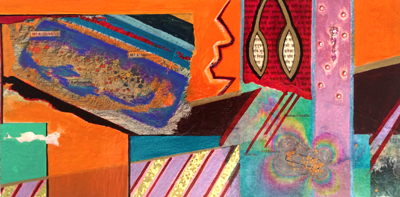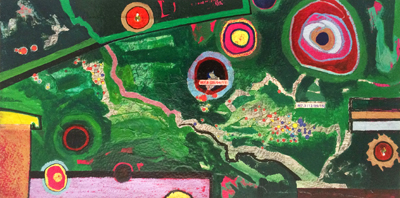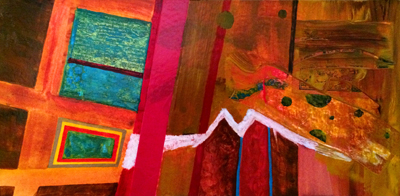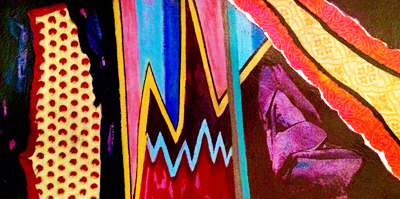Profile: Adam Swart— Who Knew Emptiness Could Weigh So Much? *
By Christina Turczyn
arttimesjournal June 26, 2019
After speaking with the artist and deeply admiring his paintings, I hesitated to look at the titles, until they fell into my hands. To even attempt to understand the lived complexity of Adam Swart's work is to wait-the work reveals itself gradually, as, other critics have noted, in layers. The text of Crimes and Celebrations: Paintings and Mixed Media Works opens up to images titled Crimes Against Humanity: Fragments of a Shattered Generation, Gross National Hypocrisy, or Kintsugi: Making Beautiful Something Broken. The Great Wagon Chronicles, after Rumi, include a piece titled Some Things Bloom in an Alternate Youniverse. Both blood and light are found there without a shred of sentimentality.
 AfTeRsHoCkS #96 Watercolor and mixed media on paper, 6" x 12", 2015 Private Collection (Photo Courtesy of Adam Swart) |
I was profoundly moved by the series Crimes Against Humanity :… and the painting What of Her Innocence? a piece that incorporates a portrait of a victim remembered on the walls of the Tuol Sleng Genocide Museum of Cambodia. When I asked Adam about the young woman in the painting, he told me that the image in the lower section of the painting is a photograph of one of the victims. "When I first began this work," he said, "I thought that I would leave the area blank…but then I added color. It was as though I were returning her life. She would have been older than I am, right now. "
The artist, whose work has been in exhibited in the United States and Nepal, is currently the Art Gallery Education Coordinator of the George Segal Gallery at Montclair State University. His most recent exhibit was Departures, at the 73 See Gallery, which mourned people whom Adam loved. One of his paintings will be shown at the Sichuan Fine Arts Institute in China in 2020, as part of collaboration between Montclair State University, Sichuan Fine Arts, and the University of Dundee in Scotland.
Formerly a Peace Corps volunteer in Nepal, as well as a groundbreaking participant in the Arts Access/Matheny School and Hospital partnership for artists with dis/abilities, Adam shared his perspectives concerning his work within the context of individual transformation, as well as international dialogue. My own work centers upon innovative educational practice, as well as the ways in which dis/ability studies might be integrated into general education curricula. We both agreed, also, that cultural diplomacy begins, at times, with discussions that are person-to-person.
 AfTeRsHoCkS #93 Watercolor and mixed media on paper, 6" x 12", 2015 Private Collection (Photo Courtesy of Adam Swart) |
CLT : "Considering Bell Hooks' concept of the ancestral memory that objects hold, I was wondering about the significance of what several critics have referred to as the layering in your work. Do you feel that objects have an ancestral memory by nature of their materiality or history?"
AS: "If you think of a painting as an object, as a life…which needs to be created, nurtured, and developed, then the multiple layers present memory. Scraping away the layers is a way of revealing that memory, and the layers present a history of the evolution of that work…There was an artist, for example, in a bookmaking project I was involved in, who left evidence of the process visible, a very process-oriented approach…"
CLT : "Can you offer an interpretation of one of your paintings? I was really interested in What of Her Innocence?"
AS: " It's difficult to describe an abstract painting in words…yet within my work there is narrative within abstraction. After leaving Nepal, I traveled to many countries, and on one occasion visited the Tuol Sleng Genocide Museum of Cambodia. Formerly a high school in Phnom Penh, which the Khmer Rouge turned into a prison, one of the buildings in the museum had a hallway filled with black and white photos of people killed, on a surface that looked like wallpaper. I was struck by the fact that so many were children. This was a violent assault on my emotion."
CLT: "Do you feel that you break silence in your work?"
 AfTeRsHoCkS #31 Watercolor and mixed media on paper, 6" x 12", 2015 Private Collection (Photo Courtesy of Adam Swart) |
AS: "Some artists are afraid to begin. I am never afraid of a blank canvas. Just make a mark. One can easily break visual silence. I am more intimidated by a painting that achieves resolution."
"When still in Nepal, I continued painting. Paintings document experience in ways that a photo cannot. Some of my work included collage elements and mixed media not replicated in drawn form. I wanted to include Tibetan prayer cards or actual postage stamps….
CLT: "What are some struggles that artists face? "
AS: "There are so many…A former professor of mine at Skidmore college, Jeff Elgin, once said that 'Doubt is an artist's passion'...Many artists need some level of discomfort to produce work….I always liked, in a song called Black Square, the Manic Street Preachers' lyrics, 'When every single day, you're haunted by perfection/Paintings are never finished, but merely abandoned.' "
"A sense of uncertainty is the nature of what it means to be an artist."
CLT : "Like chaos theory?"
AS : "Yes, like that."
CLT: " Can you say what you liked about Rumi's poetry, which inspired your Great Wagon Chronicles?"
AS: For several years, I have been an admirer of his work-his ability to articulate a spiritual richness -he metaphorically addresses that through simple, everyday experiences. The last two lines of the poem present a non-duality. "Come to the orchard in spring/There is light and wine and sweethearts/in the pomegranate flowers. If you do not come, these do not matter/If you do come, these do not matter." Where does that come from? "
CLT: " Would you like to share what was most meaningful to you about your Peace Corps experience?"
 AfTeRsHoCkS #3 Watercolor and mixed media on paper, 6" x 12", 2015 Private Collection (Photo Courtesy of Adam Swart) |
AS: " I could talk about the Peace Corps forever. It was a life-changing experience. There was no phone in the village when I arrived. I believe there was one phone in the village when I left. It was not tainted by technology. The Peace Corps is all about human interaction. I allowed myself one hour of painting a week, yet mostly I felt that I should be out there, playing volleyball with my village."
"The work that I created during that time period was about reflection, taking into account not just events, but my place in Nepal as an outsider. The community was overwhelmingly warm and welcoming."
"I taught over one hundred third- to sixth-graders."
CLT: What was the hardest part of leaving Nepal?
AS: "Shortly before I left, I felt as though realizations were dropping with the weight of bombs. Nepal felt like home. The war with Iraq had just begun. I remember one evening, walking through a valley with my students, watching the sun set, and realizing that this was finite. The hardest part was returning to the United States."
"A friend of mine asked me what it felt like to leave. I asked if he knew what it was like to break up with someone after a long relationship. Now, I told him, multiply that by eight hundred-the number of people in my village."
CLT: " When the earthquake hit, you created a compassionate and responsive project. Can you say more, concerning AfTeRsHoCKs?"
AS : "For three days after the earthquake hit, there were 98 aftershocks. I wanted to create 98 paintings in 72 hours. It was Memorial Day Weekend, and I only slept for twelve hours during that time. All but ten paintings were sold for Save the Children, while the remaining ten were exhibited in Nepal."
"It took twenty-four hours before I knew what happened in my Peace Corps village."
 AfTeRsHoCkS #66 Watercolor and mixed media on paper, 6" x 12", 2015 Private Collection (Photo Courtesy of Adam Swart) |
CLT : "I know that in the past, you worked as a painting instructor with Arts Access, among other organizations. You mentioned, as well, that the Matheny/Arts Access program was transformative for you ."
AS : "Arts Access was a wildly revolutionary and impressive program. It was not art therapy, but being a physical paintbrush for people whose bodies were broken. The work empowered people to share what they could not share in any other way…I learned about individuality, patience, and cherishing the uniqueness of each individual. I appreciate the gifts of communication."
"I look at this [outdoor] space before us, and think about the members of our dance department."
"Dancers process the world and our experiences. A painter requires a brush; a writer needs a laptop or a notebook-a dancer just needs the body. They see this stage and imagine moving bodies through that space, along with music…"
"Dance is the purest form of art. Just you."
As I myself dislike resolution, I cannot offer any easy summary of Adam
Swart's work. I can only say that it is the work of genius. I think of
several works as the alchemy of grief--what remains is the self beyond
whatever can be lost: Photographs, fire, circles, brilliance, contrast,
questioning, edge.
* Title from an e-mail written by Adam Swart as part of the project AfTeRsHocks. May 1, 2015
